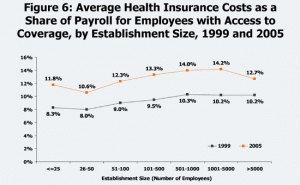The House plan for health reform has an employer mandate for employers with a payroll of $250,000 or more(pdf). Businesses with a payroll for $400,000 or more must either provide health insurance, or pay 8% of payroll to “subsidize” health care for their employees.
Take a look at the graph on the right hand side. It’s a little out of date (2005) but it shows payroll percentage costs of insurance. The numbers are higher than the government numbers, because it only includes companies which do provide insurance and doesn’t average costs in of employees they don’t provide insurance for.
In other words, as of 2005, this was the cost of actually providing insurance for employees. Since then it’s only gone up, rising faster than inflation. You’ll notice, that for companies of all sizes, it’s more than 8%, although this doesn’t include the value of any tax deductions to the companies.
The costs do vary by size, both because smaller pools of employees tend to cost more (because variability of claims varies more the smaller the pool) and because larger firms tend to have better plans (the latter seeming to outweigh the former, to my surprise).
This will change as time goes on. The House plan will eliminate discrimination by size, which should decrease costs for smaller employers, but it will also mandate the minimum acceptable plan characteristics, which will probably raise their costs. No matter what the case, however, what’s clear is that from a pure price perspective, for most employers, dropping their health coverage and paying the 8% “subsidy” is the price effective option. This is especially true since, while a flat 8% is automatically indexed to inflation, if health care costs continue to rise faster than inflation, and I expect they will, despite various efforts to contain them, the bottom line calculus each year will become even more favorable to dropping coverage.
The end result of this will be that more and more employers will simply drop their insurance plans and throw their employees onto the public insurance exchanges. Assuming that the public option is cheaper and generally comparable to the private plans (not a sure thing, which I may discuss in a later post), this will mean that large numbers of people will wind up in the public plan. Larger numbers, I think, than the current scoring expects.
Unless the public plan can reduce costs to what would be 8% or less of payroll, this means the cost of the public plan may be higher than expected, and since the private companies shedding their insurance plans won’t be making up the difference (8% being less than their own costs) that means premiums will also be higher than one might otherwise like.
Since companies won’t be (as far as I can tell) forced to return the difference in what they were paying in insurance to employees, that means employees will very likely be more out of pocket than they were before the plan.
And if that’s the case, support for the plan will collapse since at the end of the day people who used to have employer insurance will have less money in pocket than they did when the company was paying for it.
This scenario is what we would expect to play out of employers act in accordance with the incentives embodied in the plan, so I regard it as rather likely unless there are incentives I’m unaware of that would prevent it or if the tax benefits of providing private insurance are large enough to outweigh the additional costs.
This isn’t necessarily either a good or bad thing. It could well lead to real single payor, for example. What’s interesting is the question of whether it’s intentional or not.


Albertde
In Quebec, the government charges 2.7% to 4.26% of gross payroll for the “Contribution to Health Services Fund”. If you don’t work for an employer (either self-employed, pensioner or “rentier” – I don’t know a short English word for this), then you pay 1% for income under $44K (max. $150 a year!) and a further 1% of income over $44K (up to an additional max. of $850 a year).
Albertde
In Quebec, the government charges 2.7% to 4.26% of gross payroll for the “Contribution to Health Services Fund”. If you don’t work for an employer (either self-employed, pensioner or “rentier” – I don’t know a short English word for this), then you pay 1% for income under $44K (max. $150 a year!) and a further 1% of income over $44K (up to an additional max. of $850 a year).
Sorry, forgot to add great post! Can’t wait to see your next post!